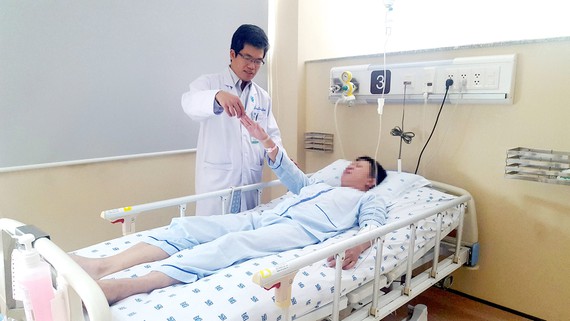 Society
Society

A shortage of stroke rehabilitation facilities nationwide is affecting recovery for many patients, doctors have said.

|
| Dr. Nguyễn Bá Thắng, head of the stroke unit at the University Medical Center in HCM City, examines a stroke patient. Photo sggp.org.vn |
HCM CITY — A shortage of stroke rehabilitation facilities nationwide is affecting recovery for many patients, doctors have said.
In Việt Nam, around 200,00 patients suffer a stroke each year, with 70 per cent of stroke patients requiring rehabilitation, according to Dr. Nguyễn Huy Thắng, head of the People’s 115 Hospital’s Cerebrovascular Disease Department.
The People’s 115 Hospital offers treatment for nearly 20,000 stroke patients a year and is constantly overloaded with stroke patients.
A rehabilitation worker has to provide stroke rehabilitation to more than 10 patients a day, with priority given to severe cases.
Patients with mild post-stroke impairment are transferred to provincial-level hospitals for rehabilitation.
Dr. Nguyễn Bá Thắng, head of the stroke unit at the University Medical Center in HCM City, said common stroke complications include paralysis, walking difficulties, depression, memory problems, and speech problems.
Rehabilitation is an important part of recovery after stroke. The goals are to regain lost abilities and skills and to achieve the best possible quality of life.
In Việt Nam, there is a shortage of stroke rehabilitation facilities, with some provinces facing an absence of stroke rehabilitation facilities, according to Dr. Nguyễn Bá Thắng.
Due to stroke patient overload, hospitals often allow patients to be discharged from the hospital after the acute phase of treatment.
Many surviving stroke patients cannot access stroke rehabilitation after returning home, resulting in poor recovery and affecting their quality of life.
According to Dr. Nguyễn Xuân Thắng, head of the People’s 115 Hospital’s traditional medicine department, said stroke rehabilitation programmes are compulsory therapy for all patients after a stroke.
The sooner patients begin stroke rehabilitation 24 hours after a stroke, the more likely they are to relearn lost abilities.
Deaths from stroke have shown a steady decline from 2013 until now, falling 17 per cent during the period compared to the years before 2013, according to statistics released by the Ministry of Health.
However, 90 per cent of patients experienced disability after a stroke, placing a burden on family and carers.
Nearly one-fourth of stroke patients experienced problems walking and needed support for daily activities, while 15-25 per cent of stroke patients totally depended on their carers. —VNS